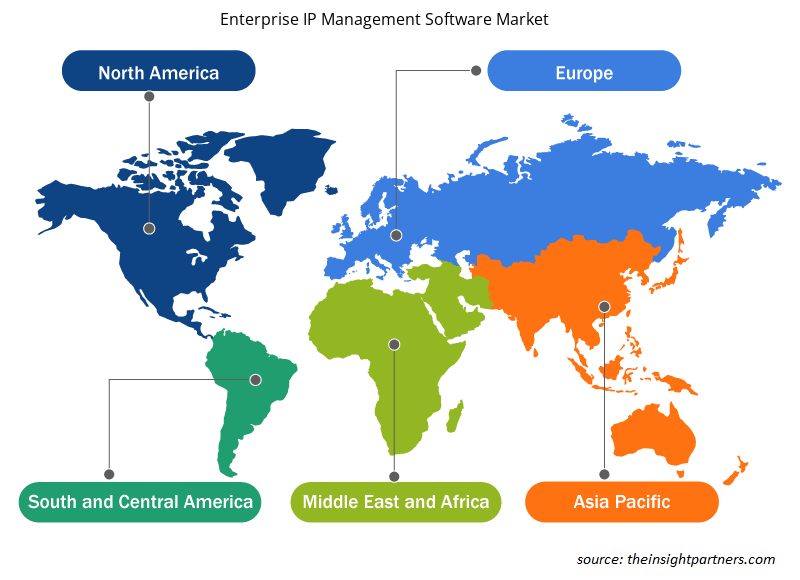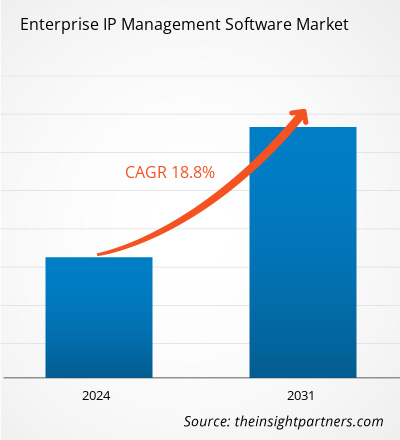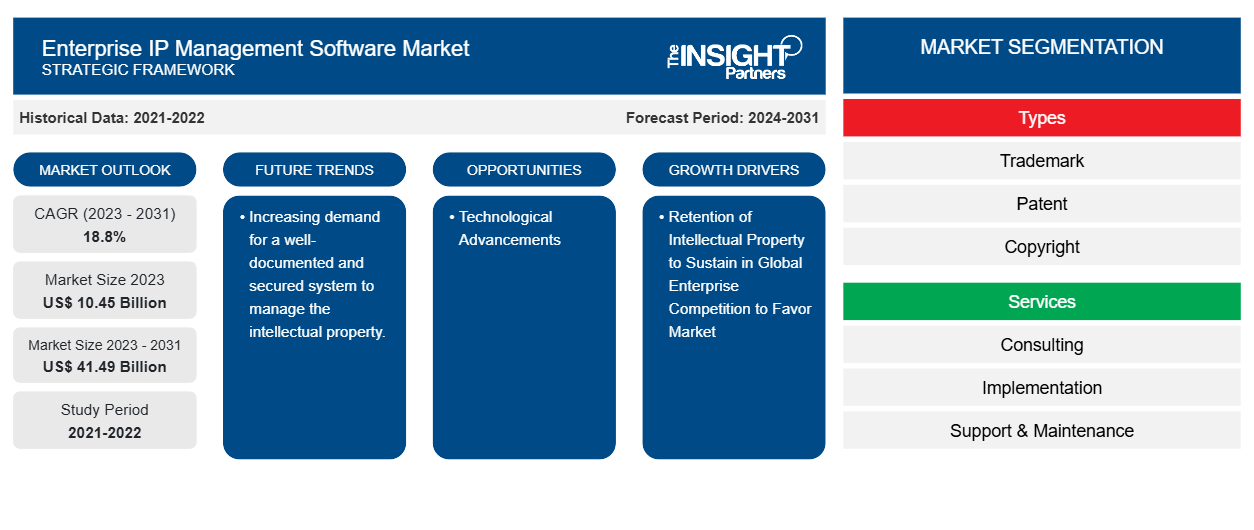Das Marktvolumen für Enterprise-IP-Management-Software soll von 10,45 Milliarden US-Dollar im Jahr 2023 auf 41,49 Milliarden US-Dollar im Jahr 2031 anwachsen. Für den Markt wird für den Zeitraum 2023–2031 eine durchschnittliche jährliche Wachstumsrate (CAGR) von 18,8 % erwartet.Der Schutz geistigen Eigentums, um sich im globalen Wettbewerb behaupten zu können, und die steigende Anzahl neuer Vertriebskanäle werden voraussichtlich auch weiterhin die wichtigsten Trends auf dem Markt für IP-Management-Software für Unternehmen bleiben.
Marktanalyse für Enterprise-IP-Management-Software
Der Markt für Software zur Verwaltung geistigen Eigentums in Unternehmen ist in den letzten Jahren stark gewachsen und wurde stark angenommen. Diese Tendenzen werden sich in den kommenden Jahren voraussichtlich fortsetzen. Entwicklungsländer sind im Zeitalter der Globalisierung für ihren wirtschaftlichen Fortschritt auf geistiges Eigentum (IP) angewiesen. Die Entwicklungsländer in der Region Asien-Pazifik beginnen, den Wert geistigen Eigentums (IP), seine Notwendigkeit und seine Auswirkungen auf Handel und Investitionen zu erkennen. Trotz der vielen Vorteile, die internationale Beziehungen (IR) bieten, mangelt es den meisten Ländern der Region Asien-Pazifik an den notwendigen Verfahren zur Erteilung und Durchsetzung geistiger Eigentumsrechte, was wiederum zu großen Verlusten für Unternehmen führt.
Marktübersicht für Enterprise-IP-Management-Software
Unternehmen, die Marken und Patente besitzen oder diese erwerben möchten, nutzen die Software für das Management geistigen Eigentums. Software für das Management geistigen Eigentums unterstützt auch Anwälte und IP-Anwaltskanzleien bei der Planung, Durchführung und dem Ausgang von IP-Anmeldungen und Rechtsstreitigkeiten.
Passen Sie diesen Bericht Ihren Anforderungen an
Sie erhalten kostenlose Anpassungen an jedem Bericht, einschließlich Teilen dieses Berichts oder einer Analyse auf Länderebene, eines Excel-Datenpakets sowie tolle Angebote und Rabatte für Start-ups und Universitäten.
-
Holen Sie sich die wichtigsten Markttrends aus diesem Bericht.Dieses KOSTENLOSE Beispiel umfasst eine Datenanalyse von Markttrends bis hin zu Schätzungen und Prognosen.
Treiber und Chancen auf dem Markt für Enterprise-IP-Management-Software
Schutz des geistigen Eigentums zur Erhaltung des globalen Unternehmenswettbewerbs zur Begünstigung des Marktes
Geistiges Eigentum ist ein wichtiges und anpassungsfähiges Instrument zur Förderung und Aufrechterhaltung der Konkurrenzfähigkeit von Unternehmen. Das Wichtigste, was Globalisierung und Handelsliberalisierung bewirkt haben, ist, dass alle Unternehmen, auch KMU, auf globaler Ebene wettbewerbsfähig sind, selbst wenn sie auf dem lokalen Markt eines Landes tätig sind. KMU benötigen einen klaren Geschäftsplan, um wettbewerbsfähig zu bleiben. Sie müssen ihre Produktivität ständig steigern, die Produktionskosten senken und den Ruf ihrer Produktlinie auf vielfältige Weise verbessern, beispielsweise durch Investitionen in Forschung und Entwicklung, den Erwerb neuer Technologien, die Entwicklung besserer Designs und die erfolgreiche Vermarktung ihrer Waren.SMEs, competitive on a global scale, even if they are operating in one country's local market. SMEs need a clear business plan in order to stay competitive. They must constantly increase productivity, lower production costs, and improve the reputation of their product line through a variety of means, such as investing in R&D, acquiring new technology, creating better designs, and successfully marketing their goods.
Technologische Fortschritte
Technologische Fortschritte können etablierte Märkte für Software zur Verwaltung von geistigem Eigentum von Unternehmen auf den Kopf stellen, neue Geschäftsmöglichkeiten eröffnen und das Kundenverhalten verändern. Unternehmen müssen mit den technologischen Entwicklungen Schritt halten, wenn sie wettbewerbsfähig bleiben wollen.
Marktbericht zur Enterprise-IP-Verwaltungssoftware – Segmentierungsanalyse
Wichtige Segmente, die zur Ableitung der Marktanalyse für Enterprise-IP-Management-Software beigetragen haben, sind Typen, Dienste und Endbenutzer.
- Der Markt für Enterprise IP-Management-Software ist nach Typ in Marken, Patente, Urheberrechte, Design und Rechtsstreitigkeiten unterteilt. Das Markensegment dürfte im Prognosezeitraum wachsen.
- Nach Dienstleistungen ist der Markt in Beratung, Implementierung sowie Support und Wartung unterteilt. Das Beratungssegment dürfte im Prognosezeitraum wachsen.
- Basierend auf dem Endbenutzer ist der Markt für Enterprise IP-Management-Software in BFSI, Pharma, Automobil, Luft- und Raumfahrt & Verteidigung, Informationstechnologie und Forschungsinstitute unterteilt. Das BFSI-Segment wird im Prognosezeitraum voraussichtlich wachsen.BFSI, pharmaceutical, automotive, aerospace & defense, information technology and research institutes. The BFSI segment is anticipated to grow in the forecast period.
Marktanteilsanalyse für Enterprise-IP-Management-Software nach geografischer Lage
Der geografische Umfang des Marktberichts für Enterprise-IP-Management-Software ist hauptsächlich in fünf Regionen unterteilt: Nordamerika, Asien-Pazifik, Europa, Naher Osten und Afrika sowie Südamerika/Süd- und Mittelamerika. Nordamerika hat den Markt für Enterprise-IP-Management-Software dominiert. Hochtechnologische Trends in verschiedenen Branchen in der nordamerikanischen Region haben das Wachstum des Marktes für Enterprise-IP-Management-Software vorangetrieben. Faktoren wie die zunehmende Einführung digitaler Tools und hohe Technologieausgaben von Regierungsbehörden werden voraussichtlich das Wachstum des nordamerikanischen Marktes für Enterprise-IP-Management-Software vorantreiben. Darüber hinaus zwingt eine starke Betonung von Forschung und Entwicklung in den entwickelten Volkswirtschaften der USA und Kanadas die nordamerikanischen Akteure dazu, technologisch fortschrittliche Lösungen auf den Markt zu bringen. Darüber hinaus gibt es in den USA viele Akteure auf dem Markt für Enterprise-IP-Management-Software, die sich zunehmend auf die Entwicklung innovativer Lösungen konzentrieren. All diese Faktoren tragen zum Wachstum des Marktes für Enterprise-IP-Management-Software in der Region bei.
Regionale Einblicke in den Markt für Enterprise-IP-Management-Software
Die regionalen Trends und Faktoren, die den Markt für Enterprise IP Management Software während des Prognosezeitraums beeinflussen, wurden von den Analysten von Insight Partners ausführlich erläutert. In diesem Abschnitt werden auch die Marktsegmente und die Geografie von Enterprise IP Management Software in Nordamerika, Europa, im asiatisch-pazifischen Raum, im Nahen Osten und Afrika sowie in Süd- und Mittelamerika erörtert.

- Erhalten Sie regionale Daten zum Markt für Enterprise-IP-Management-Software
Umfang des Marktberichts zur Enterprise-IP-Management-Software
| Berichtsattribut | Details |
|---|---|
| Marktgröße im Jahr 2023 | 10,45 Milliarden US-Dollar |
| Marktgröße bis 2031 | 41,49 Milliarden US-Dollar |
| Globale CAGR (2023 - 2031) | 18,8 % |
| Historische Daten | 2021-2022 |
| Prognosezeitraum | 2024–2031 |
| Abgedeckte Segmente |
Nach Typ
|
| Abgedeckte Regionen und Länder |
Nordamerika
|
| Marktführer und wichtige Unternehmensprofile |
|
Dichte der Marktteilnehmer für Enterprise-IP-Management-Software: Auswirkungen auf die Geschäftsdynamik verstehen
Der Markt für Enterprise IP Management Software wächst rasant, angetrieben durch die steigende Nachfrage der Endnutzer aufgrund von Faktoren wie sich entwickelnden Verbraucherpräferenzen, technologischen Fortschritten und einem größeren Bewusstsein für die Vorteile des Produkts. Mit steigender Nachfrage erweitern Unternehmen ihr Angebot, entwickeln Innovationen, um die Bedürfnisse der Verbraucher zu erfüllen, und nutzen neue Trends, was das Marktwachstum weiter ankurbelt.
Die Marktteilnehmerdichte bezieht sich auf die Verteilung von Firmen oder Unternehmen, die in einem bestimmten Markt oder einer bestimmten Branche tätig sind. Sie gibt an, wie viele Wettbewerber (Marktteilnehmer) in einem bestimmten Marktraum im Verhältnis zu seiner Größe oder seinem gesamten Marktwert präsent sind.
Die wichtigsten Unternehmen auf dem Markt für Enterprise-IP-Management-Software sind:
- Anaqua, Inc.
- Klären
- WebTMS
- Cardinal Intellectual Property, Inc.
- Patrix AB
- Flextarc
Haftungsausschluss : Die oben aufgeführten Unternehmen sind nicht in einer bestimmten Reihenfolge aufgeführt.

- Überblick über die wichtigsten Akteure auf dem Markt für Enterprise-IP-Management-Software
Neuigkeiten und aktuelle Entwicklungen zum Markt für Enterprise-IP-Management-Software
Der Markt für Enterprise-IP-Management-Software wird durch die Erfassung qualitativer und quantitativer Daten nach Primär- und Sekundärforschung bewertet, die wichtige Unternehmenspublikationen, Verbandsdaten und Datenbanken umfasst. Im Folgenden finden Sie eine Liste der Entwicklungen auf dem Markt:
- Im Februar 2023 gab Resurgens Technology Partners, eine auf Software spezialisierte Private-Equity-Firma, bekannt, dass ihr Portfoliounternehmen Wellspring, der führende Anbieter von Innovations- und IP-Management-Software, die Übernahme von IP Pragmatics, einem führenden Beratungs- und Dienstleistungsunternehmen für Technologietransfer und geistiges Eigentumsmanagement, abgeschlossen hat.
(Quelle: Resurgens Technology Partners, Pressemitteilung, 2023)
- Im April 2022 kündigte Anaqua, der führende Anbieter von Technologie für Innovation und geistiges Eigentumsmanagement, Pläne für die Veröffentlichung seiner neuen automatisierten Informationsoffenlegungslösung als Teil seines AQX IP-Managementangebots für Unternehmen und Anwaltskanzleien an. Das neue System wird IP-Experten helfen, Zeit und Geld zu sparen, indem es den IDS-Prozess rationalisiert und automatisiert.
(Quelle: Anaqua, Pressemitteilung, 2022)
Marktbericht zur Enterprise-IP-Management-Software – Umfang und Ergebnisse
Der Bericht „Marktgröße und Prognose für Enterprise-IP-Management-Software (2021–2031)“ bietet eine detaillierte Analyse des Marktes, die die folgenden Bereiche abdeckt:
- Marktgröße und Prognose auf globaler, regionaler und Länderebene für alle wichtigen Marktsegmente, die im Rahmen des Projekts abgedeckt sind
- Marktdynamik wie Treiber, Beschränkungen und wichtige Chancen
- Wichtige Zukunftstrends
- Detaillierte PEST/Porters Five Forces- und SWOT-Analyse
- Globale und regionale Marktanalyse mit wichtigen Markttrends, wichtigen Akteuren, Vorschriften und aktuellen Marktentwicklungen
- Branchenlandschaft und Wettbewerbsanalyse, einschließlich Marktkonzentration, Heatmap-Analyse, prominenten Akteuren und aktuellen Entwicklungen
- Detaillierte Firmenprofile
- Historische Analyse (2 Jahre), Basisjahr, Prognose (7 Jahre) mit CAGR
- PEST- und SWOT-Analyse
- Marktgröße Wert/Volumen – Global, Regional, Land
- Branchen- und Wettbewerbslandschaft
- Excel-Datensatz
Aktuelle Berichte
Verwandte Berichte
Erfahrungsberichte
Grund zum Kauf
- Fundierte Entscheidungsfindung
- Marktdynamik verstehen
- Wettbewerbsanalyse
- Kundeneinblicke
- Marktprognosen
- Risikominimierung
- Strategische Planung
- Investitionsbegründung
- Identifizierung neuer Märkte
- Verbesserung von Marketingstrategien
- Steigerung der Betriebseffizienz
- Anpassung an regulatorische Trends























 Kostenlose Probe anfordern für - Markt für Enterprise-IP-Management-Software
Kostenlose Probe anfordern für - Markt für Enterprise-IP-Management-Software